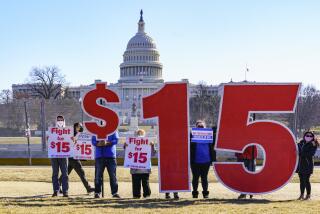Middle-Class Workers Ailing in Census Checkup
WASHINGTON — The Census Bureau’s annual snapshot of economic health in America offered a yellow warning light for the middle class, as an unchanged poverty level and a widening erosion of health insurance coverage tarnished news that household income was finally beginning to rise.
Household income rose from 2004 to 2005 for the first time since 1999, the agency said in its report, released Tuesday.
But even that news contained a mixed message. Earnings of full-time workers fell during that period, and incomes rose partly because there were more households in which a second adult joined the workforce.
Democrats portrayed the report as evidence that the circumstances of many families had deteriorated under President Bush. “Our economy is moving in the wrong direction, and President Bush and the Republicans in Congress are woefully out of touch with this fact,” said House Minority Leader Nancy Pelosi (D-San Francisco).
Rob Portman, Bush’s budget director, had a different interpretation. He said the economy’s ability to bounce back from the 2001 terrorist attacks and Hurricane Katrina a year ago “is a testament to the strong work ethic of the American people, the resilience of our economy and pro-growth economic policies, including tax relief.”
Adjusted for inflation, the median income of U.S. households increased by 1.1% last year to $46,326, its highest level since 2001. The median marks the point where half of households received more income and half received less.
Gains were substantially greater for high-income households than those at the bottom of the scale. “This is a pretty unbalanced expansion,” said Jared Bernstein, a senior economist for the liberal Economic Policy Institute.
The poverty rate last year was 12.6%, a statistically insignificant decline from the previous year’s 12.7%. Poverty had been climbing since 2000.
Altogether, nearly 37 million people lived below the government’s poverty line in 2005, or 90,000 fewer than in 2004. The poverty line, which varies with family characteristics, was $19,806 last year for a family of four with two children younger than 18.
The number of people without health insurance rose by about 1.3 million in 2005, to 46.6 million. That amounted to 15.9% of the population, up from 15.6% in 2004 and the highest level since 1998.
The number of insured people also rose by 1.4 million.
Interest groups including the American Medical Assn. and the health insurance industry, as well as some healthcare policy experts from both ends of the political spectrum, said the numbers underscored the need for Congress and the president to confront the problems of the uninsured, as well as of healthcare costs that were relentlessly rising faster than overall inflation.
“This confirms that the patchwork system we have today of employer coverage with backup government programs doesn’t work,” said Nina Owcharenko, a health policy analyst at the conservative Heritage Foundation. “The numbers may create a catalyst for action.”
The census numbers showed that employer coverage and other types of private insurance continued to shrink in 2005 and that government programs failed to expand to pick up the slack.
In 2005, private plans provided coverage for 67.7% of the population, compared with 68.2% in 2004. Government programs covered 27.3% -- including many who also had private insurance -- in both years.
The number of uninsured children increased by more than 350,000 in 2005, to a total of just over 8.3 million, despite a government program to provide coverage to low-income children.
But most of the increase in the ranks of the uninsured was among working-age people, particularly those in their mid-40s to mid-60s. Nearly 80% of the uninsured were U.S. citizens, despite a popular perception that many are illegal immigrant laborers.
Bush’s main healthcare initiative -- tax-sheltered health savings accounts for routine expenses, coupled with low-cost insurance for major medical problems -- does not seem to have slowed the erosion of private coverage yet. “They are not increasing the number of people with health insurance,” said Harvard economist Katherine Swartz.
The brightest note in Tuesday’s release of economic data came in the income figures. Median household income rose enough to wipe out the last two years of declines.
But from 2000 to 2005, the median household income fell 2.7%.
Robert Greenstein, executive director of the liberal Center on Budget and Policy Priorities said that even after four years of growth, median incomes are lower than they were in late 2001, at the end of the last recession.
In 2001, the median income was $46,569 in 2005 dollars, or $243 more than in 2005.
Greenstein said the increase in the median income from 2004 to 2005 was driven by a sharp increase for elderly households. For households headed by someone younger than 65, he said, the median income fell by 0.5%, leaving it $2,000, or 3.7%, lower than it was in 2001.
The richest 20% of households enjoyed a gain in income of more than $3,000 in 2005, to $159,583.
The poorest 20%, by contrast, gained $68, to a total of $10,655.
The richest fifth of households received 50.4% of all income, the highest level since the Census Bureau began compiling such data in 1967. The poorest fifth got 3.4%, tying a record low first reached in 2003.
The poverty rate came down more sharply for some groups in 2005 than for others. The non-Latino white poverty rate slid from 8.7% to 8.3%, while the rate for blacks rose from 24.7% to 24.9%.
Some analysts regard the poverty data as misleading. Douglas J. Besharov, a poverty expert at the conservative American Enterprise Institute, said the 2004 poverty rate of 12.7% would have been more like 5% if the calculation included unreported income, benefits from the earned income tax credit and such non-cash income as food stamps.
Still, Besharov said, the poverty rate, however it is measured, is higher than it should be, especially in inner-city neighborhoods.
“There aren’t enough such neighborhoods in enough states with enough senators to cast the votes to make anything happen,” he said.
More to Read
Inside the business of entertainment
The Wide Shot brings you news, analysis and insights on everything from streaming wars to production — and what it all means for the future.
You may occasionally receive promotional content from the Los Angeles Times.










